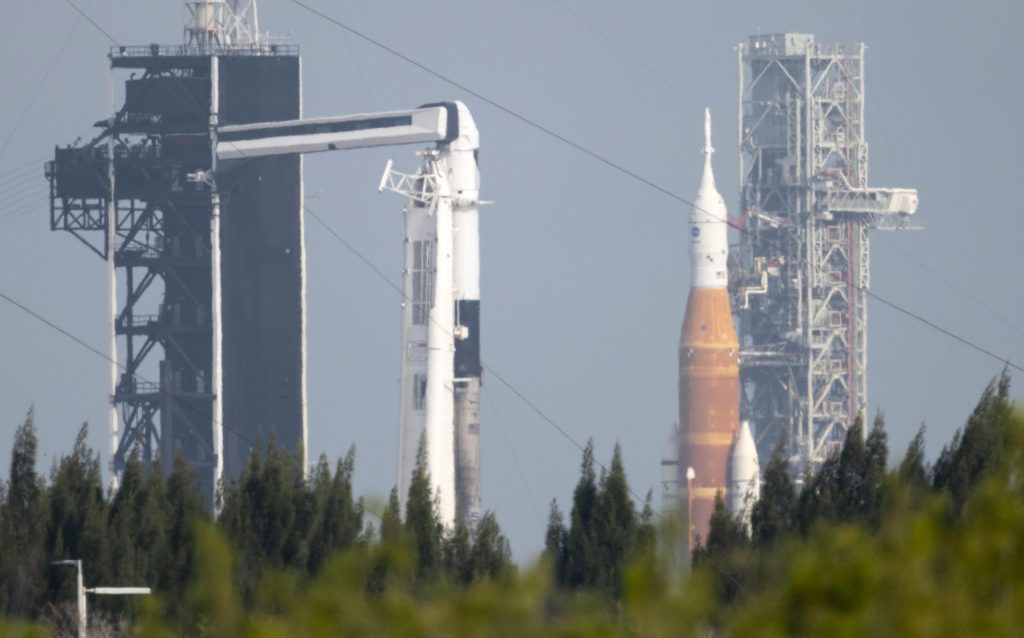

El cohete del Sistema de Lanzamiento Espacial (SLS) de la NASA con la nave espacial Orion a bordo se ve sobre una plataforma de lanzamiento móvil en el Complejo de Lanzamiento 39B mientras el equipo de lanzamiento de Artemis I se prepara para su próximo intento de prueba de ensayo con ropa mojada, al igual que un cohete SpaceX Falcon 9 con la nave espacial Crew vio el Dragón de la compañía a bordo de la plataforma de lanzamiento en el Complejo de lanzamiento 39A mientras continúan los preparativos para la Misión Axiom 1 (Ax-1), el miércoles 6 de abril de 2022, en el Centro Espacial Kennedy de la NASA en Florida. La misión Ax-1 es la primera misión privada de astronautas a la Estación Espacial Internacional. Los miembros de la tripulación del Ax-1, el comandante Michael López-Alegría de España y los Estados Unidos, el piloto Larry Connor de los Estados Unidos, los especialistas de la misión Eitan Stipe de Israel y Mark Bathy de Canadá se lanzaron el 8 de abril desde el Complejo de Lanzamiento 39A en el Centro Espacial Kennedy. Crédito: NASA/Joel Kosky
interim cryogenic propulsion stage (ICPS) with the ground systems at Kennedy. Due to the changes in loading procedures required for the modified test, wet dress rehearsal testing is slated to resume with call to stations on Tuesday, April 12 and tanking on Thursday, April 14. Wet dress rehearsal is an opportunity to refine the countdown procedures and validate critical models and software interfaces. The modified test will enable engineers to achieve the test objectives critical to launch success.
Engineers have identified a helium check valve that is not functioning as expected, requiring these changes to ensure safety of the flight hardware. Helium is used for several different operations, including purging the engine, or clearing the lines, prior to loading propellants during tanking, as well as draining propellant. A check valve is a type of valve that allows liquid or gas to flow in a particular direction and prevents backflow. The helium check valve is about three inches long and prevents the helium from flowing back out of the rocket.
Following the modified test, the Space Launch System rocket and Orion spacecraft will return to the Vehicle Assembly Building (VAB) where engineers will evaluate the valve and replace if needed. Teams are confident in the ability to replace the valve once back in the VAB.
NASA will host a teleconference to discuss details on Monday, April 11. Check back at this blog for an update on the countdown timeline prior to the modified wet dress rehearsal testing for the Artemis I mission. NASA is streaming live video of the rocket and spacecraft on the Kennedy Newsroom YouTube channel.





More Stories
¿Cómo se hicieron los agujeros negros tan grandes y rápidos? La respuesta está en la oscuridad.
Una vaca marina prehistórica fue devorada por un cocodrilo y un tiburón, según los fósiles
El lanzamiento del cohete Falcon 9 de SpaceX se ha detenido a medida que se acercan dos importantes misiones de vuelos espaciales tripulados.